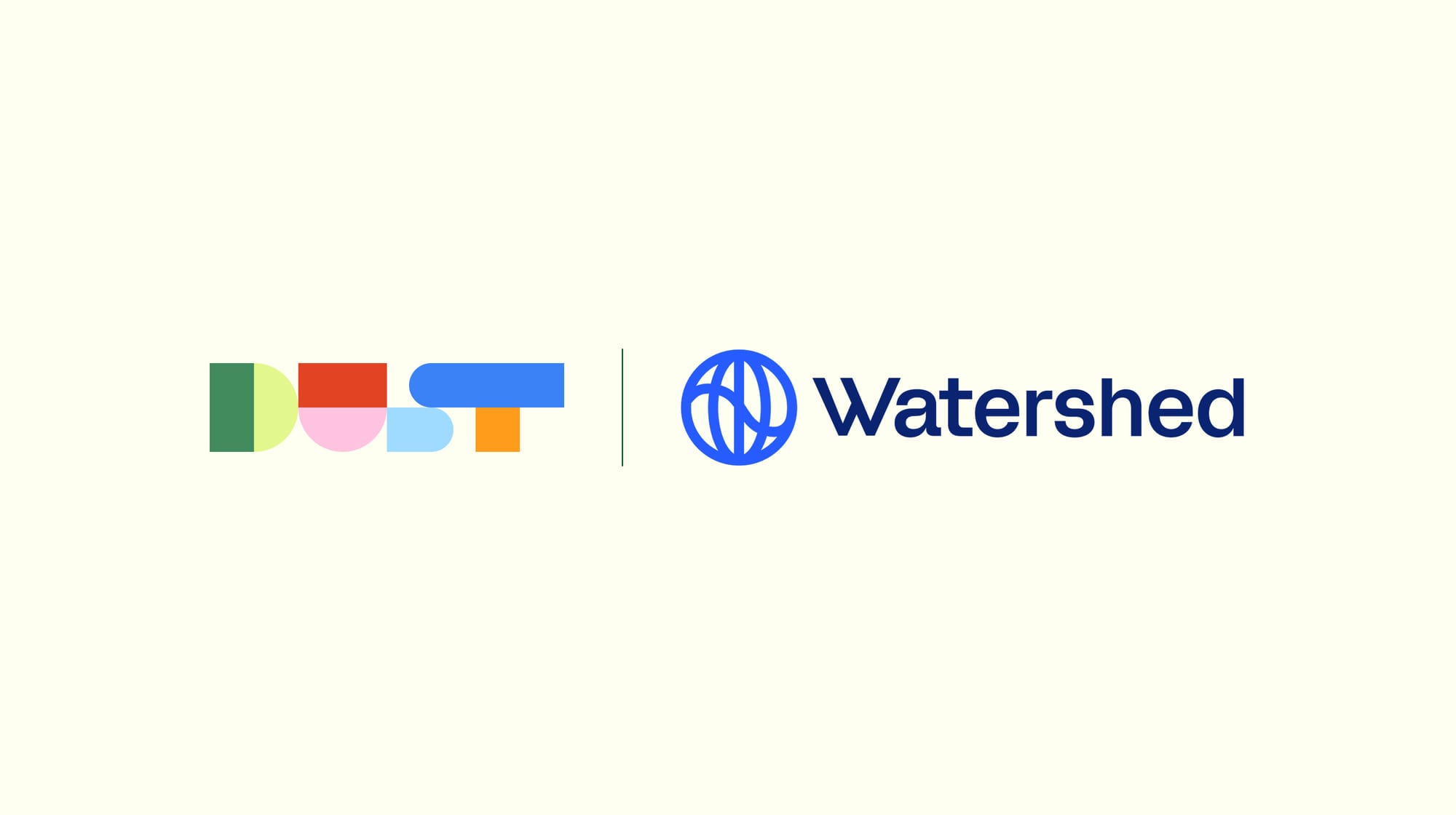How Watershed got 90% of its team to leverage Dust agents

Watershed is an enterprise sustainability platform used by companies like Airbnb, Carlyle Group, FedEx, Visa, and Dr. Martens to manage climate and ESG data, produce audit-ready metrics for voluntary and regulatory reporting including CSRD, and drive real decarbonization.
Based in San Francisco, Watershed has been experimenting with AI since its founding. But with the rapid pace of AI advancement and the company's commitment to building best-in-class sustainability software tools, Watershed decided to invest even more deeply in integrating AI across the company.
We sat down with Vinjai Vale, AI Lead, and Jonathan Glidden, Head of Data and Climate Science, to understand how Watershed used Dust to build AI fluency across the company, identify high-impact use cases, and achieve over 90% company-wide adoption.
The Opportunity: Building AI fluency across Watershed
Since the company's launch in 2019, Watershed has been building momentum with AI through grassroots experimentation. "A lot of it was bottom-up and product-led," Vinjai explains. "Since the early days of GPT-3 and GPT-3.5, our engineers have been doing experiments to understand how we can use this technology to make our workflows and product even better."
In January 2024, the leadership team made a renewed commitment to investing in AI initiatives. One of their priorities included leaning more into the tools they were already using—one of which was Dust.
As Jonathan explains, one of Watershed's co-founders, Avi Itskovich, had signed up for Dust as one of their AI experiments. "Even though we had never invested in any form of official implementation, Dust was already actively used by part of the employee base," Jonathan explains.
With this new strategic commitment, Watershed was ready to deploy Dust at full force across the entire organization. "Dust was a lightweight solution that we could start using immediately that could give us a shared set of vocabulary and mental models for everybody at Watershed to be able to learn about using agents," Vinjai says.
Implementation: A multi-pronged approach to encourage Dust usage
To encourage more employees to use AI, Watershed launched multiple coordinated tactics to drive successful adoption:
Embedding champions on every team
“We had embedded DRIs [Directly Responsible Individuals] on every single team at Watershed, who are responsible for identifying AI use cases with Dust within their respective teams,” Vinjai explains.
This created a network of AI advocates who could identify the most relevant use cases and build solutions tailored to their teams. “The distributed nature of Dust really allowed us to take a two-person team and scale up what we could do,” Vinjai adds.
Offering hands-on support with office hours and pairing sessions
The Watershed team also focused on lowering barriers for employees. “Some people are naturally early adopters and love to tinker, but most people aren’t like that. For those employees, it helps to have someone they can ask questions to or partner with,” Jonathan says.
To support this demographic, the company set up comprehensive support systems—including office hours and enablement sessions—to make AI adoption a collective experience rather than an individual challenge.
Demonstrating value through tangible proof points
The team focused on proving value through demos. "We wanted to help people understand AI capabilities by taking a very demo-led approach," says Vinjai. Identifying real problems within departments and showing how Dust could solve them helped people build an intuitive understanding of the technology and, in turn, generated more ideas for use cases. The team also closely tracked adoption metrics, sharing weekly newsletters with the entire organization. These updates not only showcased progress but also helped build excitement and buy-in. "The whole company was working toward that goal, and people were genuinely excited about it," Jonathan explains.
Results: Widespread adoption and diverse use cases
Since Watershed’s deep investment in Dust in January 2024, the company has seen remarkable progress:
Use cases across every function
Thanks to Dust, Watershed has unlocked AI use cases across a variety of functions. “The biggest success we’ve seen with Dust has been as a general-purpose tool that many people have been able to use across different functions. It’s been great to see so many employees get up to speed on building an agent for a task that’s important to their work,” Jonathan says.
Some examples include:
- Sales development: Sales development reps created a Dust agent to research prospects and draft outbound emails. The agent follows a basic playbook, returning key information in a clear, digestible format that reps then use to personalize their outreach.
- Sales operations: The sales team built agents integrated with Gong and Salesforce to process notes from calls, extract key takeaways aligned with Watershed’s sales methodology, and write summaries back into Salesforce — saving the sales team significant time on manual updates.
- Engineering: Engineering teams use Dust for design documentation based on internal templates. The agent is especially valuable for completeness checks, prompting engineers to consider critical details they might otherwise overlook.
- People: Watershed also built a Dust agent that acts as a performance review coach, which quickly gained widespread adoption. “About a third of the company uses this agent for reviews,” Vinjai says. The agent guides employees on how to approach and write their reviews more thoughtfully.
Increased AI fluency
Vinjai and Jonathan have also observed a significant change in how their employees understand and use AI. "We had lots of AI skeptics six months ago," Vinjai explains. "Today, employees have developed real fluency with these tools. Employees went from thinking AI was a fun novelty you could use for 1% of your job to understanding that—for many roles—if you're not using AI actively, you're not working as effectively as you could be."
Adoption at scale
A clear signal of success has been the rapid adoption of Dust across the organization. Watershed went from having 20% to 90% of employees actively using the platform within months, bringing them closer to their goal of making AI an embedded part of every employee’s work.
As a result of this widespread adoption, Watershed employees are seeing improved productivity across the board. “We found Dust to be really useful at speeding up workflows—not just in terms of efficiency, but also in terms of quality,” Vinjai notes.
Using Dust to scale AI efforts across Watershed
With Dust, Watershed was able to spearhead one facet of their AI-focused initiatives by empowering the company to build custom agents tailored to their specific workflows and business requirements. "We've seen a huge benefit from using Dust to build what we need internally, rather than buying an off-the-shelf solutions," Vinjai says.
By combining the right platform with systematic enablement—from embedded champions to hands-on support—Watershed demonstrated how organizations can successfully scale AI fluency and achieve meaningful adoption across hundreds of employees.

